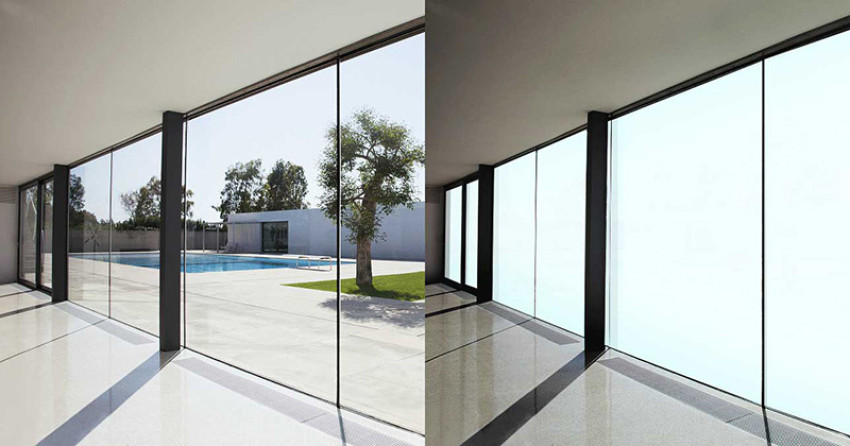
Smart glass, also known as switchable glass or privacy glass, is a revolutionary technology that has gained popularity in recent years. This innovative glass has the ability to change its transparency or opacity with the flick of a switch, offering a wide range of applications in various industries. In this article, we will delve into the technology behind smart glass, exploring its working principles, benefits, and potential applications.
How Does Smart Glass Work?
Smart glass operates on the principle of electrochromism, which involves the reversible change in color or opacity of a material in response to an electric current. There are several types of smart glass technologies available, each with its own unique working mechanism. Let's examine a few of the most frequently encountered ones:
1. Polymer Dispersed Liquid Crystal (PDLC) Technology
PDLC technology is one of the most widely used methods for creating smart glass. It consists of a thin layer of liquid crystal droplets dispersed in a polymer matrix. In its natural state, the liquid crystals are randomly oriented, scattering light and making the glass opaque. Yet, when an electric current is introduced, the liquid crystals align, enabling light to penetrate and rendering the glass transparent.
2. Suspended Particle Device (SPD) Technology
SPD technology involves embedding microscopic particles, such as suspended droplets or nanocrystals, in a film or glass pane. These particles are suspended in a liquid or gel-like substance. When an electric current is applied, the particles align and allow light to pass through, making the glass transparent. In the absence of an electric current, the particles disperse randomly, scattering light and making the glass opaque.
3. Electrochromic Technology
Electrochromic smart glass utilizes thin films of electrochromic materials, such as tungsten oxide or viologens, sandwiched between two conductive layers. When a small electric voltage is applied, ions migrate within the film, causing a change in color or opacity. This technology offers precise control over the level of transparency and can be adjusted to various shades.
4. Thermochromic Technology
Thermochromic smart glass relies on the properties of certain materials that change color or transparency in response to temperature fluctuations. These materials are embedded or coated onto the glass surface. When heated or cooled, the material undergoes a reversible phase change, altering its optical properties and changing the glass's transparency.
Benefits of Smart Glass
Smart glass offers numerous benefits across different industries and applications. Here are some key advantages of using smart glass technology:
1. Privacy and Security
One of the primary benefits of smart glass is its ability to provide instant privacy and security. With a simple switch or control system, the glass can transition from transparent to opaque, preventing unwanted visibility into private spaces. This feature is particularly useful in office conference rooms, healthcare facilities, and residential settings.
2. Energy Efficiency
Smart glass can significantly contribute to energy efficiency in buildings. By adjusting the transparency of the glass, it allows for better control of natural light and heat gain. In its opaque state, smart glass can block out sunlight, reducing the need for air conditioning and artificial lighting. This can lead to energy savings and a more sustainable environment.
3. Versatility and Aesthetics
Smart glass offers versatility in design and aesthetics. It can be integrated into windows, partitions, doors, and even curved surfaces. The ability to switch between transparent and opaque states provides flexibility in creating dynamic and interactive spaces. Smart glass can also be customized with patterns, colors, and even digital displays, adding a touch of innovation and style to any environment.
4. UV Protection
Smart glass has the ability to block harmful ultraviolet (UV) rays. By adjusting the opacity of the glass, it can effectively reduce the amount of UV radiation entering a space. This feature is particularly beneficial in areas where UV protection is essential, such as museums, art galleries, and spaces with valuable artwork or artifacts.
Applications of Smart Glass
Smart glass technology has a wide range of applications across various industries. Here are some notable examples:
1. Architecture and Construction
In architecture and construction, smart glass can be used for windows, skylights, and facades. It allows for better control of natural light, privacy, and energy efficiency in buildings. Smart glass can also be used for dynamic advertising displays, creating interactive storefronts and facades.
2. Automotive Industry
Smart glass is increasingly being used in the automotive industry. It can be integrated into car windows, sunroofs, and rearview mirrors, providing privacy, glare reduction, and UV protection. Smart glass can also enhance the driving experience by reducing heat buildup inside the vehicle.
3. Healthcare Facilities
In healthcare facilities, smart glass can be used for privacy partitions, patient rooms, and operating theaters. It allows for instant privacyand visibility control, creating a more comfortable and secure environment for patients and medical professionals. Smart glass can also be used in laboratories and cleanrooms, where privacy and controlled lighting conditions are crucial.
4. Hospitality Industry
The hospitality industry can benefit from smart glass in various ways. It can be used for privacy partitions in hotel rooms, conference rooms, and restaurants. Smart glass can also be incorporated into spa areas, providing privacy for guests while maintaining a serene and relaxing atmosphere.
5. Retail and Advertising
Smart glass offers exciting possibilities for retail and advertising applications. It can be used for interactive storefronts, digital signage, and product displays. With the ability to switch between transparent and opaque states, smart glass can create captivating visual experiences and engage customers in a unique way.
Conclusion
Smart glass technology has revolutionized the way we perceive and interact with glass surfaces. Its ability to switch between transparent and opaque states, along with its numerous benefits, makes it a versatile and innovative solution for various industries. From enhancing privacy and security to improving energy efficiency and aesthetics, smart glass offers a wide range of applications. As technology continues to advance, we can expect further developments and advancements in the field of smart glass, opening up new possibilities for the future.
Remember, the key to the successful implementation of smart glass lies in understanding its technology, benefits, and potential applications. By harnessing the power of smart glass, businesses, and industries can create dynamic, efficient, and visually appealing spaces that cater to the needs of their users.
So, embrace the future of glass technology and explore the endless possibilities that smart glass has to offer!




